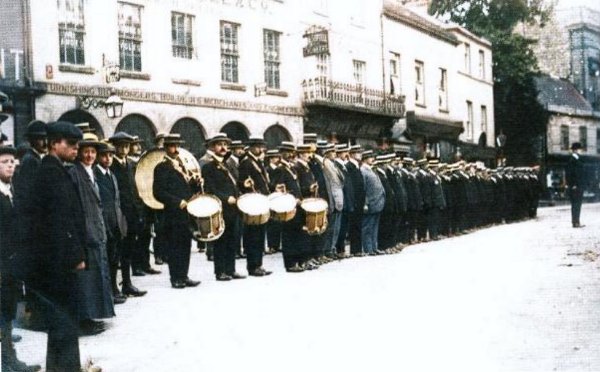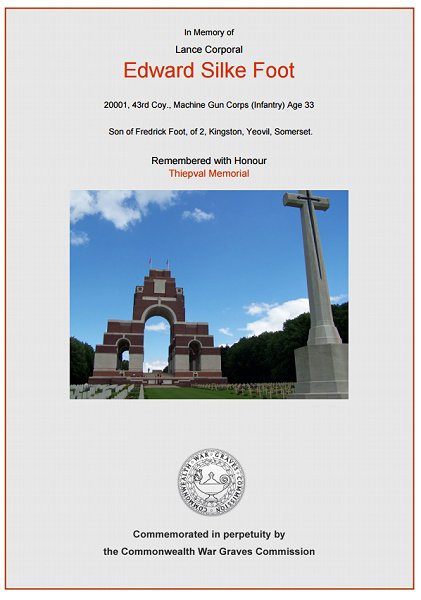yeovil at War
Edward Silke Foot
Killed in action during the Somme Offensive
Edward Silke Foot was born in Yeovil in 1883, the son of painter and decorator Frederick Foote (1846-1931) and Salome née Stone (1848-1895) originally from Bristol. In the 1891 census Frederick and Salome were living at 15 Higher Kingston with their children, all Yeovil-born; Frederick A (b1879), Sidney H (b1881), eight-year old Edward and John R (b1886), together with Frederick's widowed mother Lucy, a visitor and a domestic servant.
Salome died in 1895 and in the following 1901 census widower Frederick was living at the same address in Higher Kingston with sons Frederick Jnr and John, together with his widowed aunt Rosamund Webber who acted as housekeeper. There was no sign of Edward at this time but it is known that he enlisted in the Somerset Light Infantry and his Service Number with the Regiment, 7379, indicates that he enlisted in 1904. After his service he became a National Reservist.
By the time of the 1911 census Frederick had moved to 2 Kingston and living with him was 28-year old Edward, Frederick's sister-in-law Susannah Webber acting as housekeeper, together with three boarders. Frederick gave his occupation as painter and decorator while Edward gave his as a coal merchant's clerk - probably working for Hubert Beare who had his coal merchant's business in Kingston.
 As
a National
Reservist at the
outbreak of war,
Edward was
called up
immediately in
August 1914 (and
is probably in
the first
photograph below
of the National
Reservists in
the
Borough). He
joined the 6th
(Service)
Battalion,
Somerset Light
Infantry.
As
a National
Reservist at the
outbreak of war,
Edward was
called up
immediately in
August 1914 (and
is probably in
the first
photograph below
of the National
Reservists in
the
Borough). He
joined the 6th
(Service)
Battalion,
Somerset Light
Infantry.
The 6th Battalion was formed in August 1914 and would be sent to the Western Front as part of 14th (Light) Division. The 6th Battalion crossed the Channel on 21 May 1915. They were in billets for the first few weeks and spent their time as working parties digging trenches southwest of Ypres. The 6th Battalion commenced its first tour in the front line on 12 June 1915.
On 26 July 1915, while at Hooge, the Battalion was subjected to a new weapon of war - the flamethrower. This event is described in the Regimental History of the Somerset Light Infantry "Very early in the morning the front-line trenches of the Brigade were suddenly flooded by liquid fire, which belched from jets in the German lines opposite. This new device momentarily caused surprise and confusion, and the victims of this dastardly attack fell back from the front-line trenches which were then occupied by the enemy."
At some time during late 1915 Edward transferred to the 43rd Company, Machine Gun Corps as a Lance-Corporal.
In 1914, all infantry battalions were equipped with a machine gun section of two guns, which was increased to four in February 1915. The sections were equipped with Maxim guns, served by a subaltern and 12 men. The obsolescent Maxim had a maximum rate of fire of 500 rounds, so was the equivalent of around 40 well-trained riflemen.
The experience of fighting in the early clashes and in the First Battle of Ypres had proved that the machine guns required special tactics and organisation. On 22 November 1914 the BEF established a Machine Gun School at Wisques in France to train new regimental officers and machine gunners, both to replace those lost in the fighting to date and to increase the number of men with MG skills. A Machine Gun Training Centre was also established at Grantham in England.
On 2 September 1915 a definite proposal was made to the War Office for the formation of a single specialist Machine Gun Company per infantry brigade, by withdrawing the guns and gun teams from the battalions. They would be replaced at battalion level by the light Lewis machine guns and thus the firepower of each brigade would be substantially increased. The Machine Gun Corps was created by Royal Warrant on October 14 followed by an Army Order on 22 October 1915. The companies formed in each brigade would transfer to the new Corps and it is most likely that Edward was transferred during this period. The MGC would eventually consist of infantry Machine Gun Companies, cavalry Machine Gun Squadrons and Motor Machine Gun Batteries. The pace of reorganisation depended largely on the rate of supply of the Lewis guns but it was completed before the Battle of the Somme in 1916.
The Battle of the Somme, also known as the Somme Offensive, was a battle of the First World War fought by the armies of the British and French empires against the German Empire. It took place between 1 July and 18 November 1916 on both sides of the upper reaches of the River Somme in France. The battle was intended to hasten a victory for the Allies and was the largest battle of the First World War on the Western Front. More than one million men were wounded or killed, making it one of the bloodiest battles in human history. The battle is notable for the importance of air power and the first use of the tank. At the end of the battle, British and French forces had penetrated 10 km (6 mi) into German-occupied territory, taking more ground than in any of their offensives since the Battle of the Marne in 1914.
It appears that Edward was shot twice during the day-to-day fighting on the Somme. He died from his wounds on 16 September 1916. He was aged 33.
On the same day, at the same place, another Yeovil lad of 43rd Company, Machine Gun Corps, Fred Hooper, was killed.
The Western Gazette, in its edition of 6 October 1916, reported "Corporal ES Foot, of the Machine Gun Corps, a former member of the 6th Somerset Light Infantry, and a late National Reservist, who joined up with the other members of the National Reserve, is reported missing. Although his parents have not received any official intimation, letters from friends, which have been received in the town, speak of him as having been severely wounded by two bullets in a recent attack. (Mr. Frederick Foot (father) lived at 2 Kingston.)"
Edward Foot is remembered on Pier and Face 5C and 12C Thiepval Memorial, Somme, France, and his name is recorded on the War Memorial in the Borough.
gallery

On Bank Holiday Monday, 4 August 1914, Yeovil men of 'E' (Yeovil) Company, 1st (West) Somerset Battalion of the National Reservists, known colloquially as the 'Straw Hat Brigade', probably including Edward Foote, line up in the Borough before marching to the Town Railway Station and travelling to Taunton. War was declared at midnight.

The Commonwealth War Graves Commission certificate in memory of Edward Foot.